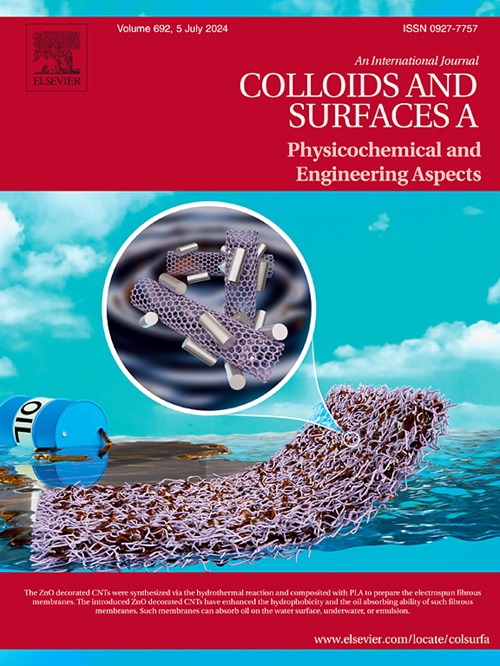Fabrication of mesoporous sorbent embedded with AuNPs for catalytic esterification of oleic acid to obtain biofuel: Textural and kinetic studies
IF 4.9
2区 化学
Q2 CHEMISTRY, PHYSICAL
Colloids and Surfaces A: Physicochemical and Engineering Aspects
Pub Date : 2025-03-31
DOI:10.1016/j.colsurfa.2025.136796
引用次数: 0
Abstract
A mesoporous silica-based support was synthesized and named MPS. It was embedded with AuNPs through their solution dropwise addition into dispersed MPS to produce MPS-AuNPs catalyst. Textural and kinetic properties of MPS-AuNPs towards catalyzed esterification of oleic acid with methanol were investigated using different instrumental and analytical techniques. Nitrogen adsorption-desorption isotherms of MPS-AuNPs showed a typical type-IV curve with an observed hysteresis loop at P/P0 > 0.82, a high BET surface area of 879 m²/g, an average pore diameter of 11.9 nm, and total pore volume of 0.38 mL/g confirming the mesoporous structure of MPS-AuNPs. TEM image confirmed the homogeneous embedding of AuNPs into the mesoporous structure with an average size of 7.3 nm. In-situ tracking of oleic acid concentration change during the catalyzed esterification process was investigated using ART-FTIR spectrophotometer to confirm the esterification process's success and to perform kinetic measurements. Reaction conditions of 1:10 oleic acid/methanol ratio, 60 °C, and 5 % catalyst loading were selected as the optimum reaction conditions where 97.3 % conversion ratio was detected. The reaction followed pseudo-first-order kinetics with a fast equilibrium time of 70 min and a reaction rate constant K = 4.33 × 10² min-¹ . The activation energy value of 32.51 kJ/mol indicated efficient catalysis. The catalyst showed excellent regeneration efficiency of 95 %, with only a 5 % drop in value after five consecutive cycles. The obtained methyl oleate's kinematic viscosity and flash point values were 4.51 mm²/s (at 40 °C) and 191 °C, respectively. This makes it suitable for the biodiesel industry after the recommended addition of antioxidants, as its oxidative stability of 2.5 hours is somewhat low. Compared to the batch process used, a continuous fixed-bed column reactor is recommended for large-scale industrial biofuel production
求助全文
约1分钟内获得全文
求助全文
来源期刊
CiteScore
8.70
自引率
9.60%
发文量
2421
审稿时长
56 days
期刊介绍:
Colloids and Surfaces A: Physicochemical and Engineering Aspects is an international journal devoted to the science underlying applications of colloids and interfacial phenomena.
The journal aims at publishing high quality research papers featuring new materials or new insights into the role of colloid and interface science in (for example) food, energy, minerals processing, pharmaceuticals or the environment.

 求助内容:
求助内容: 应助结果提醒方式:
应助结果提醒方式:


